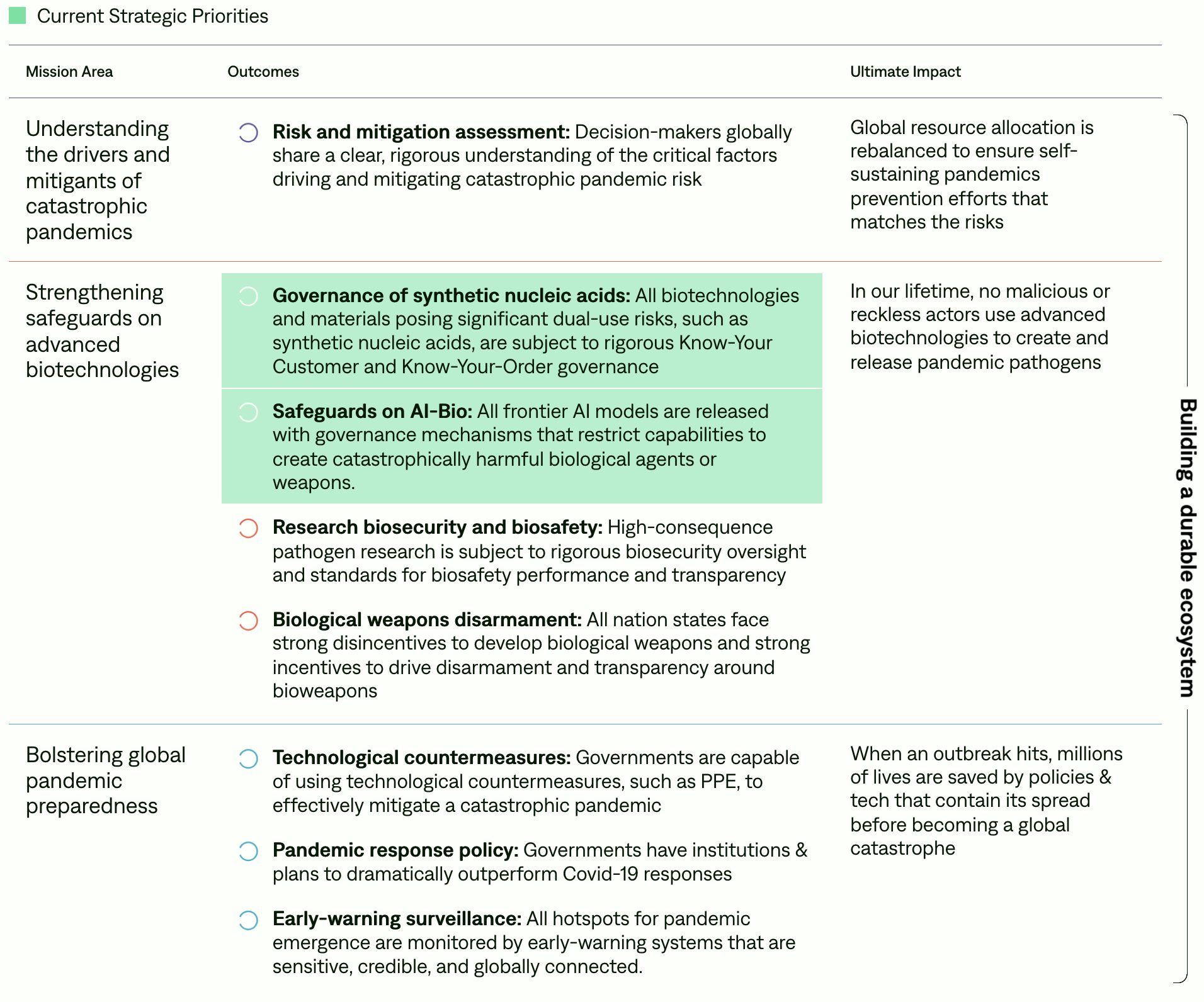As we mark Sentinel’s first year, we find ourselves more focused than ever on a specific area: the opportunities and risks at the intersection of AI and biology. Recent evidence from our partner organizations has given us a strong sense of urgency: an independent study found that early-2025-era AI models outperformed 94% of human virologists on expert-level questions, with some models achieving twice the accuracy of experts in their own specialties. Meanwhile, only 3% of biological design tools had any safety measures in place as of early 2025, while multiple red-teaming studies have demonstrated gaps in screening protocols for synthetic DNA orders.
This combination — AI systems that increasingly can assist the process of designing and constructing hazardous biological agents, paired with lacklustre safeguards — amplifies existing biosecurity challenges and compels us to act decisively. We’re currently concentrating on two complementary interventions: securing AI models at the source and strengthening screening where digital designs become a physical reality through DNA synthesis.
We’ve also been reflecting on our broader organizational strategy, and specifically, whether to take a specialist approach (maintaining a laser focus on our key priorities for biotechnology governance) or a portfolio approach (spreading our resources across pandemic prevention, detection, and response). In this post, we want to share how we think about focus and why we’ve chosen to double down rather than expand our scope.

Where Sentinel Started
We founded Sentinel last year to make pandemics history within our lifetimes. We were emboldened by the wins that philanthropy has already achieved in the fight against extreme biological risks, including catalyzing hundreds of millions of dollars in government investment in pandemic preparedness, developing governance frameworks that now inform national policies, and building a global ecosystem of capable organizations and talented individuals equipped to tackle emerging threats.
We were also deeply humbled by the audacity of taking on such a civilization-scale mission: truly ending pandemics requires fully understanding their drivers and mitigants, creating guardrails to allow powerful biotechnologies to be safely unleashed, and bolstering preparedness to the point where we can stop any outbreak in its tracks. Each of these goals comprises complex problems that require entirely new solutions, countless hours of dedicated effort — and, frankly, far more financial capital than society has mustered so far.
A Strategic Fork in the Road: Porfolio or Specialist
When we founded Sentinel, we outlined a concrete set of outcomes we would need to achieve to accomplish our mission:

Since Sentinel’s early days, we’ve grappled with how broad our scope should be — in a nutshell, at what pace should we expand our strategic priorities (coloring in the green spaces in the strategy table above)? In extensive discussions internally, with our advisors and our board, and with our numerous research partners, we have reflected on two ways of tackling this list of aspirational outcomes: a portfolio approach and a specialist approach.
The portfolio approach recognizes that eliminating pandemics requires multiple layers of defense. Just as we need both DNA synthesis screening and AI model safeguards to prevent engineered pandemics — because a determined actor might circumvent either one alone — we also need early detection systems and stockpiled countermeasures in case prevention fails. Following this approach, Sentinel would spread resources across prevention, detection, and response, building resilience at every stage.
The specialist path observes that while comprehensive defense matters, each player on the global pandemic prevention team may create more impact through deep expertise in one domain. Consider the task of safeguarding powerful biological AI models: despite mounting evidence that AI models may pose new biological threats, only 3% of biological design tools had any safety measures in place as of early 2025. Moving from such a dismal baseline to meaningful coverage will require the type of sustained, intensive effort that’s impossible when our attention is divided. Under this approach, Sentinel would pour everything into mastering one critical layer while trusting others to strengthen the rest.
Where We’ve Landed: Doubling Down on Our Highest Priorities
In Sentinel’s first year, two lessons have pointed us decisively toward the specialist path. First, we’ve seen firsthand how focus accelerates progress; by maintaining a narrow scope, we’ve been able to work much closely with our partners, develop a clearer vision for where we need to go, and make significantly more progress toward it. Second, concentrating intensely on biotechnology governance has made it clear that we are nowhere near reaching diminishing returns — simply put, we still find it easy to spend our time and capital without running out of incredibly promising opportunities.
Taken together, these two insights have led us to double down rather than branch out. Instead of expanding into the pandemic countermeasures space — as we planned to do going into 2025 — we’re continuing to focus intensely on two tightly linked pillars of work: safeguarding powerful biological AI models and improving the governance of synthetic nucleic acids.
We have seen substantial progress in both domains during 2025: the evidence base around risks from biological AI models is rapidly maturing, and several countries are taking real steps towards more robust oversight of the synthetic nucleic acid industry. We’re proud that we and our partners have played a meaningful role in bringing us to this point — but we still have a long way to go to achieve the level of risk-reduction that we believe is both necessary and possible. We believe that this degree of focus gives us the best shot at making a real difference, while capturing the genuine efficiencies that come from pursuing two interventions that share stakeholders, policy windows, and technical frameworks.
Meanwhile, we will keep rooting for the people doing incredible work in other indispensable dimensions of pandemic preparedness, trusting them to work just as relentlessly as we do on other layers of defense.
Looking Ahead, What Comes Next
Right now, we will double down on our bet on biotechnology governance, aiming to ward off the most pressing threats posed by AI-enabled biological systems. Over the last year, we have developed a deeper conviction in our theses and partners, and we now believe we have a clear path to meaningfully driving down risks through AI-model safeguards and nucleic acid synthesis governance interventions. In the coming year, we plan to make decisive bets to produce credible evidence on the risks and benefits of AI-Bio tools, build robust technical model-level safeguards, and develop practical policy roadmaps.
Beyond that horizon, we won’t pretend to know precisely where we’ll focus. This is deliberate: we have built Sentinel’s governance, operations, and culture around adapting quickly to opportunities and risks as they arise. This past year alone has upended our field: AI capabilities have continued to outpace forecasts, while global health security funding has collapsed. In the coming years, we expect the pace of unprecedented change to grow even faster.
What we can say with certainty is that Sentinel is committed, first and foremost, to our mission of taking the worst pandemic risks off the table, and that we will relentlessly seek the highest-leverage way to do that. This may mean narrowing our scope further or pivoting to other priorities for biotechnology governance – we’re currently investigating other materials and services beyond nucleic acid synthesis that could warrant stronger access controls for security and safety. If technological advances and the global health security landscape change in ways that necessitate it, we remain open even to fundamentally rethinking our approach altogether.
Whatever form it takes, we’ll be doing the work to ensure that the worst pandemics remain forever hypothetical.
Claire Qureshi, Janika Schmitt, Joshua Monrad

